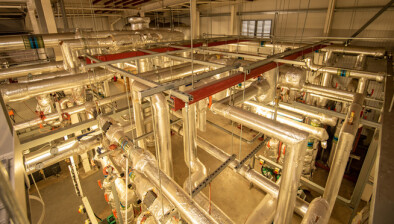Blog: Eight tools to tackle fuel poverty
 Ahead of yesterday’s Scottish Parliament debate on fuel poverty, Scottish Greens housing spokesperson Andy Wightman says it’s time to consider what more can be done to steward our housing wealth as a public asset into homes that are warm, watertight and fit for the future.
Ahead of yesterday’s Scottish Parliament debate on fuel poverty, Scottish Greens housing spokesperson Andy Wightman says it’s time to consider what more can be done to steward our housing wealth as a public asset into homes that are warm, watertight and fit for the future.
Many houses and tenements across Scotland have stood for 100 years or more. With some investment and maintenance, they can remain homes for another century.
We pay to live in our homes, either as tenants or owners, but when we are gone another generation will move in. Well built, warm and watertight homes will last across generations. In this sense, Scotland’s housing stock is not a private asset. Taken together it is a public good that we should steward for the future.
At the end of last month, the Scottish Government target to eradicate fuel poverty in Scotland’s homes expired. We have not met it; not nearly. Green MSPs have had successes – Green budget negotiations over the last five years have helped deliver £77 million more for fuel poverty programmes and Alison Johnstone secured energy efficiency as a national investment priority. But thousands still find it impossible to meet their fuel bills and almost 50 per cent of Scottish homes fail basic quality standards.
Expert groups have made over 100 recommendations for action on fuel poverty. I believe it’s time to move on from pilot project after pilot project and upscale our commitment - some Green ideas are below.
Eight tools to tackle fuel poverty:
On average 35 per cent of people in Scotland are living in fuel poverty, but the figure varies widely across the country and is in excess of 70 per cent in the Western Isles. This figure has more than doubled since the Scottish Government target to end fuel poverty was set in 2002. Those living in a fuel poor home face higher risks of poor health and lower educational attainment, as well as the added stress of having to make difficult choices between heating and putting food on the table or buying a new school uniform.
An important first step to address this would be to set a target for all homes to achieve a minimum energy efficiency standard. I would like to see the Scottish Government aim for all homes to achieve an Energy Performance Certificate of at least Band C by 2025, as recommended by the Existing Homes Alliance. Recent legislation in both England and Wales will prevent landlords issuing a lease on a property that fails to meet basic standards from April 2020.
In Scotland we also have the power to do just that. The Climate Act 2009 allows Scottish Ministers to set minimum efficiency standards at point of sale or rent, but these powers have yet to be used. The drafting of Scotland’s next Climate Bill over the coming months offers us an opportunity to make bolder provisions to protect Scottish tenants.
Decades of under-investment have left almost half of our homes below basic quality standards. Many suffer from dampness or outstanding repair work and have little insulation. But our housing stock has been built to last; it’s estimated that some 85 per cent of the homes we will have in 2050 have already been built. Given this, it’s essential that we start to take co-ordinated steps to tackle the retrofitting backlog. Taking a street-by-street approach can reduce costs of making upgrades, particularly in areas of tenement buildings where scaffolding and other construction equipment will only need to be set up once.
The Scottish Government has committed to rolling out a range of retrofitting measures, from laying insulation to installing smart meters, through its Scottish Energy Efficiency Programme (SEEP) due to start in 2018.
I would like to see SEEP initiatives rolled out with a central objective of removing poor energy efficiency as a driver of fuel poverty.
A new approach to building maintenance is needed. This could include new legislation to facilitate common repairs, enhancing the role of Home reports and including mandatory energy efficiency measures in the sale of properties with a clear price tag attached.
Removing VAT on building repairs would make it more affordable for homeowners to carry work to prevent leaks and draughts in their homes. The Swedish Government is due to vote next month on a similar proposal to end VAT charges on appliance repairs before extending this to home repairs. Though powers over VAT lie with Westminster, the Scottish Government could begin placing pressure for similar action to be taken in the UK.
Greens have also proposed a not-for-profit repair service to manage large-scale communal repairs in building blocks and tenements. This service could be managed by a mix of local authorities, housing associations and voluntary agencies.
Many of Scotland’s homes weren’t designed with the aim of maximising energy efficiency, but we don’t need expensive architecture to build homes that require less energy to heat them. Even with our small amount of Scottish sunshine, simple measures such as orientating homes to receive the maximum amount of sunlight will mean our buildings need less heat to keep warm. Building cavity walls with heat absorbing concrete blocks would also store heat at peak points in the day and slowly release this overnight as temperatures cool.
Reducing demand for energy in such a simple way will also reduce household fuel bills, addressing two of the key drivers of fuel poverty.
Greens also propose repealing planning laws that allow the capture of land value uplift by landowners. Unlike in countries such as Germany, housing costs are increased because of the requirement to pay the huge uplift that arises from the granting of planning permission. Eliminating this will free up around 30 per cent of the cost of an average new house to invest in higher standards.
It’s been 15 years since the definition of fuel poverty was set in Scotland. Under the current definition, 58 per cent of those in fuel poverty would not be considered to be income poor. This is partly because income is calculated before households have paid the costs of their rent or mortgage, and so fails to account for those who pay more 10 per cent or more of their disposable income on heating bills once high housing costs are taken into account.
The Scottish Government’s Poverty and Inequality Advisor, Naomi Eisenstadt, and the Scottish Fuel Poverty Strategic Working Group suggest that the definition of fuel poverty is updated to ensure that support is better targeted towards those on low incomes.
6. Bridge the Skills Gap.
We need more than just the vision to if we are to see on-the-ground reductions in fuel poverty rates. To roll out retrofitting or install domestic heating we will need people with a range of practical skills and knowledge from insulation laying, renewables engineering, fitting biomass boilers and assessing the energy efficiency of homes.
The Scottish Government has already pledged to deliver 30,000 Modern Apprenticeship starts by 2030, and these could include a range of opportunities to build skills in construction, surveying and engineering, or taking part in the delivery of a not-for-profit repair service.
We can be much bolder in tackling rising fuel bills by pushing the limits of Scotland’s newly devolved powers to create a Scottish Fuel Poverty Scheme funded by contributions from the largest energy companies. These providers already participate in the UK Government’s Energy Company Obligation (ECO), where they must take action to promote insulation measures and connections to district heating systems, particularly in areas of low income.
The Scotland Act 2016 devolved new powers to Scottish Ministers to determine how these funds are targeted. I believe this is an opportunity to encourage those who make the greatest profit from energy sales to offer more support to those who are most struggling to heat their homes.
Addressing fuel poverty is at least as much about treating households as it is treating homes. As well as repairing and improving the energy efficiency of homes occupied by those in fuel poverty we need to do much more to address the social and economic problems that both cause the problem and are exacerbated by it. These include poor physical and mental health, lower levels of education, social isolation, and rurality. This requires a move away from traditional modes of delivering energy efficiency measures and towards much greater engagement with frontline services able to offer face-to-face and in-home support to both better identify and support those in greatest need – specifically GPs and the NHS, local authorities, housing associations, and mental health support services.
The benefits of this would be not just reducing fuel poverty, but building resilience to fuel poverty and related welfare problems, and so ensuring that once households are lifted out of fuel poverty the risks of them falling back into it are minimised, and also enabling them to be more resilient to any sudden changes in energy prices caused by our increasingly unstable political environment.
(Dr Keith Baker of Glasgow Caledonian University also contributed to this article.)








